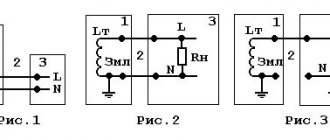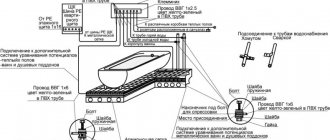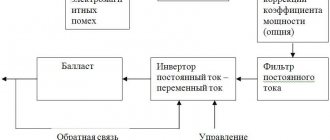What danger does high voltage pose to humans?
Even the smallest exposure to electric current on the human body can cause damage. It is necessary to take into account not only the fact of how strong the electric shock will be, but also how long it will act on the body. Dangerous stress for a person can even be minimal, since much still depends on the body itself. The current cannot be seen with your own eyes, determined by sound or smell; the effect begins when a person comes into contact with it.
Conditions for the existence of electric current
- Presence of charge carrier particles. What is actually called electric current. Please note that the impersonal concept of “particle” is deliberately used. As will become clear a little later, there are good reasons for this.
- Potential difference. In more detailed terms, it is an electric field characterized by the potential difference between two points, voltage.
- Closed circuit. There is a temptation to replace it with “conductor”, but a conductive substance does not have to be a conductor, and without the absence of a beginning and an end, a drain - a source, there is no movement of charge.
How can current affect the human body?
Electric current can instantly spread upon contact throughout the body. In order for it to pass through the body, it needs an “entry” place, and then the current, passing through the entire body, has an irritating effect on it. For example, the effect of current on the human body is divided into several types:
- Thermal, when you get a burn.
- Mechanical, when soft tissue ruptures.
- Chemical is directly electrolysis itself.
As a result of an electric shock, a person’s muscles may involuntarily contract, breathing may be paralyzed, and the heart may stop.
Danger of electric current to humans and consequences
In everyday life and at work, we come across various electrical appliances and electrical installations. By following electrical safety rules and having knowledge in this area, you can reduce the likelihood of being exposed to dangerous electric current and voltage.
This issue combines engineering and medical knowledge, the use of which in combination will increase the result in reducing the level of electrical injuries at home and at work.
The effect of electric current on the human body
Current, unlike other hazardous media, is colorless, odorless, and invisible.
Electric current has the following types of effects on the human body: thermal, electrolytic, biological. Let's look at each of these impacts in more detail.
The thermal effect consists of burns to areas of the body, heating of blood vessels and nerve endings. This type of action is also called thermal. Because thermal energy obtained from electrical energy creates burns.
Electrolytic exposure leads to the decomposition of blood and other fluids in the body through the process of electrolysis, which causes disturbances in the physico-chemical composition of these fluids. The essence of the damage comes down to the molecular level - thickening of the blood, changes in the charge of proteins, steam and gas formation in the body.
The biological effect of electric current on the body is accompanied by irritation and excitation of organs. This causes spasms and contractions.
In the case of the heart and lungs, this effect can be fatal due to the cessation of respiratory and cardiac function.
Biological effects cause mechanical damage to human organs and joints. Mechanical damage can also be caused by a person falling from a height due to exposure to electric current.
What voltage is considered dangerous for humans?
If a person is in a dry room, then the voltage for him is dangerous, which turns out to be over 36 volts. Death can occur with a shock of 0.1 ampere. A current of 0.05 amperes is also dangerous to life. The fact is that with such a current strength, convulsions occur that do not give a person the opportunity to move away from the source of the lesion.
If we are talking about static electricity, then such electricity does not pose a danger to human life. The maximum that the human body can feel from the impact of a spark discharge is an injection. Alternating current poses a great danger to human life. Dangerous voltage for humans is over 50 V, and under unfavorable conditions (humidity, for example) – over 12 V. Dangerous current – 50 mA. It is the current of this force that can cause damage, and its effect on the human body within 5 seconds can become fatal.
Dangerous current values
Electrical injury is affected by the following three factors, which determine the result:
- Current strength.
- The direction in which current flows through the body.
- Frequency (variable or constant).
Electric current is also classified according to its strength depending on how it affects human health:
- Noticeable (nothing serious, irritates the skin, up to 0.6 milliamps).
- Non-releasing (periodic alternating current pulses, the person seems to be stuck to the source, current strength is more than 0.025 Amperes).
- Fibrillation (the most dangerous, causes fibrillation of internal organs, including the heart; if the current is more than 0.1 Ampere, then death is possible).
Additionally, a lot depends on the individual resistance of the human body, which is not only different for everyone, but also varies depending on various factors. Therefore, the force of the blow may also depend on the psychological state (mood) and general health, not to mention properly selected shoes and clothing.
Based on safety regulations, the following voltage indicators are dangerous for the body:
- 65 Volts - for ordinary residential and public premises that are heated, and their humidity reaches 60%.
- 36 Volts – for rooms with high humidity levels (75%), these are kitchens, basements, etc.
- 12 Volts - for extremely wet rooms (100%), these are boiler rooms, bathhouses, laundries, swimming pools, etc.
Be aware that the frequency of electricity can also be dangerous. The current in household sockets (50-60 Hz) and in devices where it is higher (up to 500) is approximately the same in impact. When the frequency is 500-1000 Hz, the current is more dangerous, but above 1000 Hz, on the contrary, the chances of injury are less.
Source yandex.net
Factors that affect the body during electric shock
It is necessary to take into account not only the strength of the electric shock, but also what path it will take through the body. It is worth remembering that the longer the current path through the human body, the more severe the consequences will be. As we have already said, alternating current is considered life-threatening; direct current does not have such a destructive effect on the human body. There are a number of additional factors that may increase the danger:
- High current strength.
- Passing it through the body. It should be noted that different tissues of the body have different resistance abilities; in most cases, the current passes through the blood vessels. The worst thing is when the path of the current runs along the entire body, for example, this can happen if the arm and legs are involved, then the current can pass through the heart, spinal cord or brain. But sometimes death can occur when current passes from hand to hand, it all depends on how high the dangerous voltage was.
- Exposure time. The time interval allowed for exposure to current should not exceed 2 seconds.
- Conductivity.
- The area where the electric shock occurs.
It is impossible to calculate exactly how the current will affect the body. Human attention plays an important role, therefore, in dangerous places, it is necessary to provide a special safety sign, which is called the “high voltage” sign.
What is considered a safe voltage?
We will send the material by email
At one of the facilities where I was doing repairs, several electrical components burned out, so I had to change all the wiring. My apprentice decided to take the initiative and, without supervision, climbed into the shield without safety precautions. Yes, he was electrocuted and had to be pulled back, but he remained alive and well. When he asked why he did this, he said that he thought that he was not grounded, because he was standing on the floor, and the voltage was not lethal. For those like him who know nothing about safe voltage, I’ll tell you more about it.
According to experienced electricians, the main danger of electric current is that it is invisible. At the same time, electricity itself, which affects the human body, can cause serious consequences, even death. In short, it has been established that a current of 50-100 mA passing through the human body is life-threatening, and more than 100 mA is fatal. In addition, there is a difference with what it hits - next we’ll look at why alternating current is more dangerous than direct current.
What role does body resistance play?
The resistance of the body depends on the condition of its skin; the following factors can have an influence:
- What condition is a person’s skin in? For example, it can be clean, it can be dirty, wet, damaged.
- What was the area of contact of the current with the skin?
- The magnitude of the applied voltage.
- What frequency current passed through the body.
- General condition of the human nervous system.
If the skin has been scratched or abraded, the dangerous stress may be minimal for death to occur because the body's resistance is reduced. The ability to resist is lost in a person who has a sweaty or dirty hand. For example, a voltage of 30 volts with dry hands does not cause severe pain, but if you touch it with a wet hand, a person will not be able to unclench his fingers and will feel severe pain. In such cases, it is customary to say that a breakdown of skin resistance has occurred.
What voltage is considered acceptable?
Statistics indicate that most electrical injuries occur from touching exposed wires. There are three safe voltages:
- In rooms where there is no increased danger, 65 volts are allowed.
- In a room where there is danger - 36 volts.
- In high-risk areas - 12 volts.
In premises of the second and third types there must be a “high voltage” sign, which will warn of danger. Often, injuries occur to employees who, by the nature of their employment, are required to work with voltages up to 1000 V, but neglect safety precautions and do not use protective equipment.
The answer to the question of what voltage is considered dangerous can be quite simple: any electric shock can cause damage, but the most dangerous is considered to be voltage from 60 V, when respiratory paralysis and cardiac arrest can occur. But this may not happen if you pay close attention to everything that surrounds a person and in some way relates to electricity. Personnel who work with high voltage and electric current must always remember safety rules and be on high alert.
So, from this article you learned what voltage is life-threatening. We hope you find this information useful.
Source
What voltage is considered safe in damp areas?
1) Below 48 V.
2) Below 36 V.
3) Below 12 V.
4) Below 32 V.
What does the number following the triangle indicate in the symbol for welds in the drawings?
1) On the size of the fillet weld leg.
2) On the thickness of the parts being welded.
3) On the welding method.
4) On the thickness of the parts being welded. and welding method.
For what purpose is a light filter installed in a welding helmet?
1) To protect the welder's eyes from harmful ultraviolet radiation when observing welding.
2) To protect the welder’s face from splashes of molten metal.
3) In order to provide better observation of metal melting.
4) In order to protect the welder’s face from the mechanical influence of the environment
environment
Keys to testPM-02.
| Question No. | Option 2. |
| 1 | 3 |
| 2 | 3 |
| 3 | 1 |
| 4 | 1 |
| 5 | 2 |
| 6 | 1 |
| 7 | 3 |
| 8 | 3 |
| 9 | 3 |
| 10 | 3 |
| 11 | 3 |
| 12 | 1 |
| 13 | 3 |
| 14 | 2 |
| 15 | 1 |
| 16 | 1 |
| 17 | 2 |
| 18 | 3 |
| 19 | 1 |
| 20 | 1 |
Branch of the state budgetary professional educational institution Duvan Multidisciplinary College. Maloyaz
I APPROVED
head branch
________________/R.V. Gibadullin./
“_____ “ ________________ 2022
Test materials
PM-02. Manual arc welding (surfacing, cutting) with a consumable coated electrode.
Profession 01/15/05. Welder (manual and partially mechanized welding (surfacing)
Option #3
Duration of training: 2y 10 months
The set of control and measuring materials was developed on the basis of the Federal State Educational Standards for the working profession:
Welder (manual and partially mechanized welding (surfacing).
Organization - developer: GBPOU Duvan Multidisciplinary College, branch: Maloyaz village.
Teacher: Burkhanov Rivol Yumadilovich
Criteria for assessing test results:
| % correct answers | grade |
| 95-100% 80-94% 50-79% Up to 50% | 5 <excellent> 4 <good> 3 <satisfactory> 2 <unsatisfactory> |
Option No. 3.
What are the main parameters that characterize the manual arc welding mode?
1) Type of current, polarity, thickness of the metal being welded.
2) The magnitude of the welding current, the diameter of the electrode, the type of current and polarity.
3) Arc voltage, grade of metal being welded.
4) Thickness of the metal being welded, grade of metal being welded
What letter of the Russian alphabet denotes titanium and chromium in steel markings?
1) Titanium-T, chrome-X.
2) Titan-B, chrome-F.
3) Titanium-T, chrome-G.
4) Titanium-T, chrome-A.
What steels are classified as high chromium steels?
1) 03Х16Н9М2, 15Х1М1Ф, 10Х18Н9.
2) 08Х13, 06Х12Н3Д, 1Х12В2МФ.
3) 10Х2М, 20ХМА, 10ХН1М.
4) 10Х2М, 20ХМА, 10Х18Н9.
What is the reason for the formation of a crater?
1) As a result of a sharp withdrawal of the arc from the weld pool.
2) A crater is formed at the site where gases are released during the welding process.
3) The crater is formed due to significant shrinkage of the metal during the crystallization process.
4) The crater is formed due to high welding speed.
What needs to be done if the set welding mode does not provide the specified penetration depth?
1) Increase the arc length when welding.
2) Increase welding speed.
3) Increase the current.
4) Reduce the current.
What is the purpose of heating the welded edges at low temperatures?
1) To increase the depth of edge penetration.
2) To fuse the base and deposited metal together.
3) To reduce the cooling rate of the seam after welding and avoid the appearance of cracks.
4) To increase the welding speed.
For what class of steels are electrodes of types E70, E85, E100, E125, E150 used for welding?
1) For welding heat-resistant steels.
2) For welding structural steels of increased and high strength.
3) For welding carbon and low-alloy structural steels.
4) For welding and low-alloy structural steels..
Indicate the role of slag-forming substances in the electrode coating?
1) Protect the molten metal from interaction with air.
2) Alloy the deposited metal.
3) Protect molten metal from splashing.
4) Protect the molten metal from spattering and alloy the metal.
Why does a welder need special clothing?
1) To protect the welder from thermal, light, mechanical and other influences of the welding process.
2) To protect the welder from electric shock.
3) To protect the welder from harmful aerosols released.
4) To protect the welder from harmful weather factors.
Please indicate the most complete list of surface requirements for welded elements?
1) Hot rolled metal may be used as delivered.
2) The surface of the welded edges must be clean, free of scale, rust, oil, grease and dirt.
3) The surface of the elements being welded must not have any traces of moisture.
4) The surface of the elements being welded must be free of traces of moisture and slag.
Which current is dangerous for humans - direct or alternating, and why?
Electrical injuries are common threats to humans that exist not only in the workplace, but also in the home. The degree of danger of such injuries is determined by a complex of factors, one of which is the type of electricity.
Therefore, before you start working with electricity, you need to know what danger electric current poses, which current is more dangerous - direct or alternating, and what electrical safety measures to take when working with electrical equipment.
Hazards of AC and DC Current
It is known that electric current can be constant or variable, but not every resident understands the difference between them and knows which has a more serious effect on the body. When asked which current is more dangerous, experts answer – alternating.
The biological effect of electricity directly depends on the intensity with which the body is exposed to it, and this is an important factor due to which fibrillation of the ventricles of the heart occurs. Lethal electric current for humans is prolonged contact with electrical conductors with a force of 0.25-80 mA. This causes spasms of the respiratory muscles and, as a result, acute asphyxia.
Electric current is dangerous for the human body, so basic safety requirements must be observed. It itself can be constant and variable, each affecting a person in its own way. Safe work with electrical installations - compliance with all rules and use of protective equipment.
Expert opinion
It-Technology, Electrical power and electronics specialist
Ask questions to the “Specialist for modernization of energy generation systems”
Duration of damaging effects On the body of each person there are areas that are most vulnerable to electric shock, as they have minimal skin resistance. Ask, I'm in touch!
Why is alternating current dangerous?
The peculiarity of alternating voltage is to change polarity with a certain frequency. Accordingly, the direction of electron flow changes with the same frequency. For humans, this type of electric current poses a serious threat, since it has a more pronounced stimulating effect on the nerves and muscles, including the heart.
With electric shocks, the death of victims most often occurs as a result of ventricular fibrillation , which is more likely under the influence of “change”. In addition, alternating current in the electrical network is more dangerous due to the low resistance of the human body in relation to it.
Under certain conditions, alternating voltage is almost completely safe. This is possible with its ultra-high frequency ( more than 20 kHz ). Safety is achieved due to the surface effect, due to which electricity flows only through the skin, affecting its upper layers and not penetrating into the internal organs.
Concepts of direct and alternating current: what is the difference?
Variable - cheaper to produce and transmitted over long distances. Its peculiarity is that its particles can change the direction of movement and size. It is this type of electricity that runs through our wires.
Direct current particles do not change their trajectory. This type of electricity is used in household appliances and computers. Variable is converted into constant by changing it in transformers. Or you can use a chemical reaction to do this, as happens in alkaline batteries.
Why is direct current dangerous?
A constant electric current flows from one pole of the circuit to the other without changing direction. A classic example of this in electrical engineering is powering consumers from batteries.
It is considered less dangerous because when it acts on a person it causes a spasm. The spasm goes away after the tension is relieved, which reduces the likelihood of critical health consequences.
However, we can talk about safety only at low DC voltage values. The higher the voltage, the stronger the danger. At voltages exceeding 500 V, direct current may be more dangerous than alternating current.
Which current is more dangerous and what is the main risk to humans?
Alternating electric current is the most dangerous for humans. It is often fatal because it can provoke ventricular fibrillation of the heart.
However, constant electricity cannot be considered safe either. The consequences of its impact are no less serious, including severe electrical injuries and mechanical injuries when the victim is thrown. difference is that a serious threat arises at high potential values - more than 500 V. People usually do not deal with such voltage in everyday life. However, it occurs quite often in industrial electrical installations.
It must be taken into account that electrical voltage is generally safe for humans. The threat is represented by the effective current generated by this voltage. The degree of threat depends on the value of this value. Thus, alternating current up to 10 milliamps is considered safe.
Which current is more dangerous?
Alternating current flows in outlets and junction boxes, making its dangers more pressing
Until now, the laws of the effects of electricity on the human body have been little studied. The nature and severity of the lesion is influenced by many factors, the most significant of which are:
- Voltage. In the range from zero to 400 V, alternating current is considered more dangerous. At around 500 V, both types of current have equal destructive power, and at a voltage of 600 V and above, direct current turns into its worst enemy. That is, at high voltage, alternating current is less dangerous than direct current.
- Frequency (for alternating current). Current with a frequency of up to 500 Hz is considered relatively safe, as is current with a frequency of over 1 thousand Hz. The most dangerous values are 600–900 Hz.
- Current strength. Serious injuries to the body can be caused by an alternating current of 20 mA or higher, as well as a direct current of at least 100 mA. With equal current strength, alternating current is more dangerous.
- Impact area. Lesions of the extremities are not as dangerous as lesions of the torso and head.
There are four degrees of severity for electric shock:
- The first is characterized exclusively by convulsive muscle contractions.
- On the second, loss of consciousness is added.
- The third stage leads to disturbances in the functioning of the heart and respiratory system.
- The fourth is clinical death.
Any stage may be accompanied by more or less severe burns.
Be attentive and careful, monitor the serviceability of electrical appliances, follow safety rules, and then you will not be exposed to electric shock.
Expert opinion
It-Technology, Electrical power and electronics specialist
Ask questions to the “Specialist for modernization of energy generation systems”
Misconceptions about electricity The reason for this is that the electric current will pass along the path with the least resistance, that is, along the shortest line that connects the phase wire to ground or neutral. Ask, I'm in touch!
Dangerous current strength for human life
Electricity can have different effects. With a low electric current, it can be completely unnoticeable or cause only mild discomfort. If this value is amperes , then the effect of the current will be dangerous to the point of death. You can evaluate the consequences of the possible action of each of the two types of electricity with different current strength (amperage) using the table data:
| Current value, mA (milliamps) | The nature of the action of electric current | |
| Constant | Variable | |
| 0.6-1.5 mA | does not appear | mild itching and tingling |
| 2-3 mA | does not appear | slight cramps appear |
| 5-7 mA | minimal skin hyperthermia and mild tingling occurs | cramps intensify, painful sensations appear |
| 8-10 mA | tingling and hyperthermia become more intense | the pain intensifies, the victim is still able to free himself from the action of the current on his own |
| 20-25 mA | in addition to increasing hyperthermia and tingling, minor cramps appear | breathing becomes difficult, paralysis of the limbs occurs, the victim is unable to free himself on his own |
| 50-80 mA | severe hyperthermia of the skin, convulsive muscle contractions, difficulty breathing | arrhythmia appears, paralysis of the respiratory muscles occurs |
| 90-100 mA | paralysis of the respiratory muscles occurs, which can lead to death | Lethal current . At 3 seconds of action, fibrillation of the cardiac ventricles develops, respiratory arrest occurs, salvation is possible only with emergency resuscitation |
These tables clearly demonstrate that alternating electric current is the most dangerous for people.
Pereosnastka.ru
Electrical safety when assembling metal structures
TO
category:
Assembly of metal structures
Electrical safety when assembling metal structures
The effect of electric current on the human body. The degree of influence of electric current on the human body is different and depends on the magnitude of the current, the path it passes through the body, the duration of the human body being exposed to the current, and resistance.
Like any conductor, the human body has resistance, and the greater it is, the weaker the effect of electric current on it. At the same time, the resistance of the human body to the passage of electric current, unlike other conductors, is not a constant value, but a variable one. Electrical resistance can vary not only between different people, but also within the same person, depending on a number of factors (skin moisture, sweat secretions, fatigue, intoxication, the presence of metal dust in the environment).
The degree of influence of current on the human body also depends on the area of contact with live parts of electrical installations and on the duration of the electric current. The larger the area of contact between the human body and the conductor and the longer the current, the greater the risk of electric shock.
Thus, dry human skin with a contact area of up to 1 cm2 has a resistance of several tens of thousands of ohms, however, with an increase in the contact area (for example, when covering the wire with the entire palm), the skin resistance decreases in proportion to the area of contact.
When the action of electric current on the human body lasts for 30 s, its resistance drops by 25%, and after 90 s - by 70%.
The strength of the effect of electric current on the human body also depends on the voltage of the current. The higher the electrical voltage, the more dangerous it is for humans, since this increases the magnitude of the current. Voltage of 12...36 V is considered relatively safe for humans.
When working in dry places and at normal temperatures (not higher than 30 ° C), electric current with a voltage of up to 36 V is safe, in damp places - up to 12 V. In these cases, in case of accidental contact with live parts of electrical installations, the strength of the current passing through the human body is will not exceed 0.01 A, which is not dangerous for humans.
Electric current with a voltage of 36 V or higher is dangerous, since at this voltage a person can be electrocuted with a fatal outcome.
A current of 0.1 A or higher is considered fatal to humans. At a current strength of 0.01 A, a person experiences convulsions; when the current strength increases to 0.015 A, it is already difficult to tear a person away from the current conductor due to convulsive muscle contractions; with a current strength of 0.025 A, it is impossible to tear a person away from the current conductor without outside help; with a further increase in current strength to 0.05-0.08 A, respiratory paralysis occurs, and then death.
In case of electrical injuries, the frequency of the electric current is also of great importance. The greatest danger is posed by alternating current with a frequency of 50 Hz, used in metal structures factories. Increasing the frequency of alternating current reduces the risk of injury to humans. Thus, high frequency current - from 200,000 Hz and above - is safe.
Prevention of electric shock. In metal structures factories, as a rule, three-phase alternating electric current with voltages of 380/220 and 220/127 V is used. Electric motors of process equipment, power tools and other three-phase current receivers are respectively switched on at 320 and 220 V, and lighting at 220 and 127 V. Electric shock can occur when a person comes into direct contact with live parts of the installation that are energized, or when they come into contact with metal parts of equipment that accidentally become energized.
Paths of electric current passing through the human body
The threat is determined not only by the dangerous magnitude of the current, but also by the path of electricity flow through the body. The destructive effect on certain organs depends on this path.
The most dangerous electric current loops
The following pathways are considered the most threatening:
Diagram of the passage of an electric current loop hand - hand
- Hand - hand. Electricity passes through the chest, up to 3.3% of the charge enters the heart.
Diagram of the passage of an electric current loop, right arm - leg
- Right hand - legs. The danger of this loop is associated with the passage of electric current through the heart (about 6.7% of the charge). Also, part of the charge passes through the spinal cord.
- Left hand - legs. Occurs less frequently than the previous loop (usually typical for left-handed people). About 3.7% of the charge affects the heart.
- Leg - leg. Characteristic when exposed to step voltage. The heart passes about 0.4% of the charge. The main threat is associated with the possibility of a person falling, as a result of which the value of the step voltage increases, and electricity passes through more dangerous loops.
- Head - legs. The danger is associated with the effect of electricity on the brain, spinal cord, and spine. 6.8% passes through the heart .
- Head - hands. One of the most dangerous loops. 7% through itself , and the brain is hit.
The effect of electric current on the human body
Most often associated with the resistance of the human body when electricity passes through it.
Depends on many external and internal factors. Even such uncontrollable ones as: emotional state, functionality of organs and systems, and finally, because of what and how much you ate for lunch yesterday.
A living example of this is the Serb Slavis Pajkic or Biba Struja. The unique capabilities of which cannot be clearly explained. Tolley physiology. Tolley genes. But most of all, the professor was right, we know how to use electricity, but we cannot give a clear definition.
It is clear that it is difficult to calculate all factors and their influence on resistance at each individual moment in time, and it is not always necessary.
If there is a need, make a calculation, for example, when choosing an RCD, it is generally accepted that the resistance of the human body is 1 kOhm. Moreover, regardless of the shape and frequency of the current.
Biological effects
The human body also differs from a piece of iron in that it reacts to electric current with a reflexive muscle contraction.
The operating principle of modern stun guns and the slightly forgotten “Cactus” active safety system is based on this feature of the human body.
Again, it is impossible to calculate who and how will react to a high-voltage pulse of tens of thousands of volts. Some will get away with a slight shock, but for others, this will be the beginning of the end.
Actually, everything written above was necessary for an adequate understanding of some of the rules, requirements and recommendations set out in the collection of documents called “Rules for the Construction of Electrical Installations” (PUE).
What types of electrical injuries exist, protective equipment and first aid
Electrical burns, depending on the nature of the impact caused to the victim, can be contact and arc. Electrical burns of the first type occur when the body comes into direct contact with a conductor. The degree of burn depends on the duration of such contact and amperage.
There are different degrees of electrical burns:
- The safest injuries are first degree , which affect only the upper layers of the skin and are expressed in its hyperthermia and slight swelling. Recovery takes place without special therapy.
- Second degree skin lesions extend deep into the germ layer . In the area affected by the electric current, blisters filled with a clear liquid form, which should not be punctured. The damaged area may be quite painful. If the affected area is small, the burn goes away without special treatment.
- The third degree is characterized by the death of cells in the inner skin layers , the formation of blisters filled with bloody fluid. Severe redness of the skin is observed in the affected area. In the worst case, it darkens, which indicates tissue necrosis. In this condition, the skin does not regenerate, so the victim requires specialized medical care.
- The most extensive injuries of the fourth degree are associated with burnout of the skin, muscles, and thermal damage to bones. This condition can pose a serious threat to life, so specialized medical care is mandatory.
Electrical marks are specific spots with clear boundaries on the surface of the skin in the area exposed to electric shock. They have a gray or pale yellow tint. The size of such spots is 1-5 mm; there is usually a depression in the center. The shape of the sign can follow the shape of the conductive part, contact with which caused its appearance. The skin in the area of the electric sign hardens. There is no pain or inflammation.
Basic norms and rules of electrical safety
The key regulatory documents regulating the field of electrical safety are the following:
- Electrical Installation Rules ( PUE. Edition 7, Chapter 1.7 ) – download
- Rules for the technical operation of consumer electrical installations ( PTEEP ) – download
- Rules on labor protection during the operation of electrical installations – download
- Instructions for the use and testing of protective equipment used in electrical installations – download
When performing any work on electrical equipment, the following rules must be observed:
- When designing and installing electrical networks, emergency devices must be used that de-energize the network in the event of a short circuit (short circuit) and in the event of a short circuit to ground. The installation of a ground loop is mandatory.
- Persons with appropriate clearance are allowed to work.
- Special clothing and personal protective equipment required by regulatory requirements must be used.
- It is not allowed to turn on and use equipment and electrical appliances if there is damage to the housing, or to use cables if damage to the insulation is detected.
- It is not allowed to carry out repair work without de-energizing the network.
- Personnel must be able to provide first aid in case of electric shock to a person.
How to Avoid Electric Shock
To prevent electric shock to a person, it is necessary to prevent the possibility of bodily contact with live parts and conductors. Therefore, all work is carried out using the necessary protective equipment. The main personal protective equipment of this type include dielectric gloves and boots, dielectric mats and stands, etc.
When working, be sure to use an insulated tool . Personnel are required to undergo training; workers must know how to avoid defeat. Before performing work, be sure to de-energize the corresponding section of the network . In this case, an information sign about the prohibition of turning on the network must be displayed on the switch or circuit breaker. It is not allowed to perform any manipulations with live conductors.
Indicator screwdriver HR28-C (12-250V)
You can check the presence of voltage using special indicator devices. The simplest and most accessible among such devices is an indicator screwdriver.











